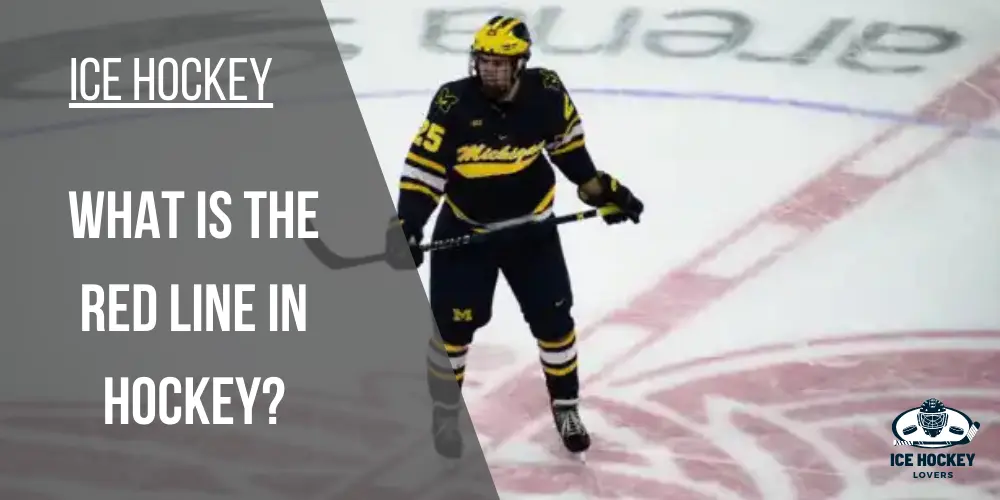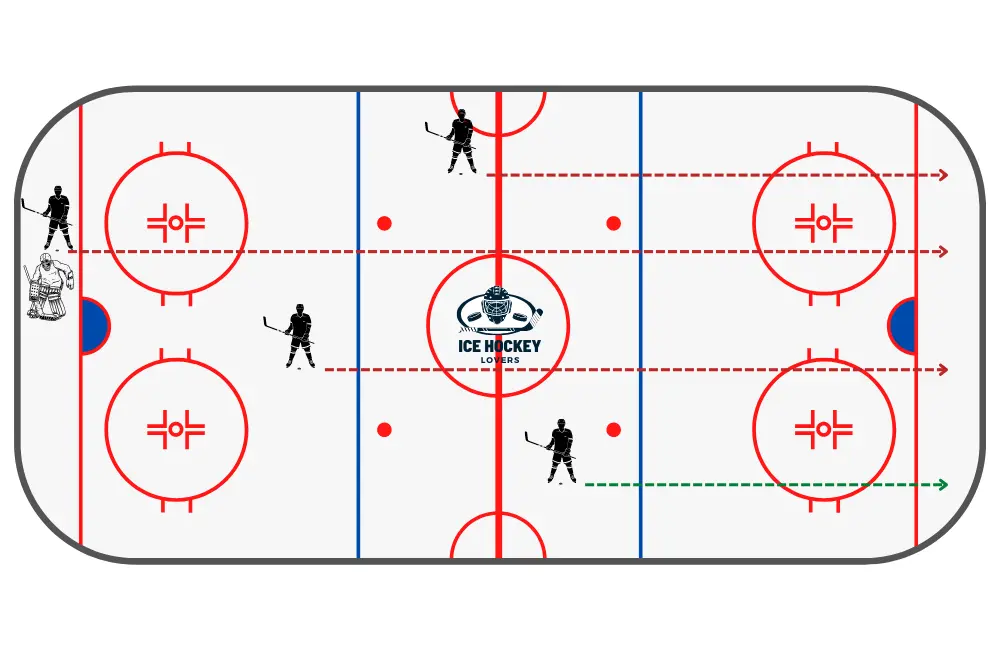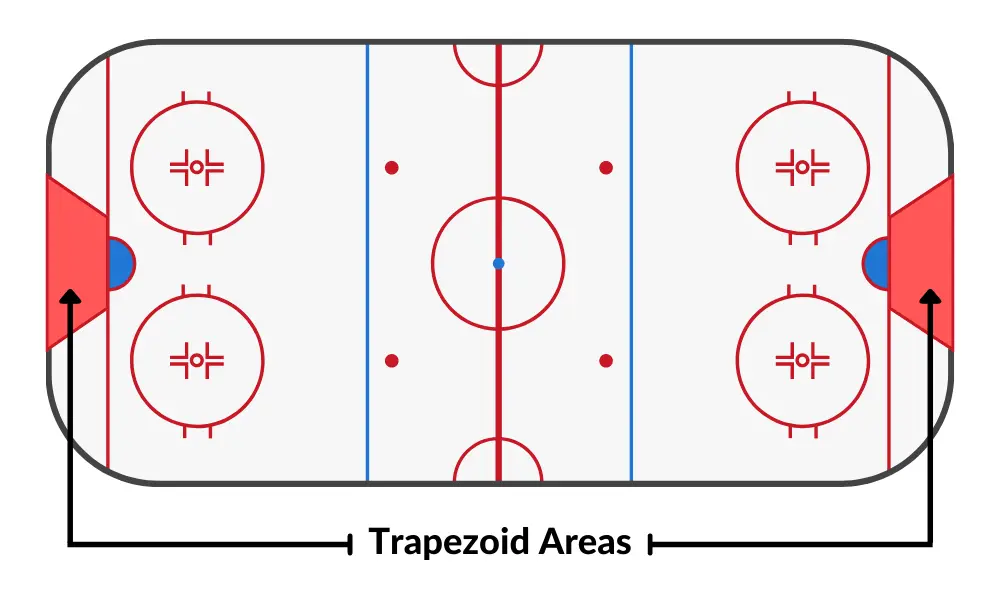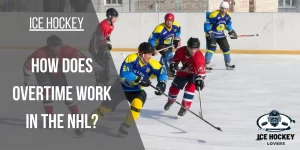Hockey Red Line: What is a Red Line in Hockey?

You must have seen the red and blue color lines on the ice hockey arena. Ice hockey surface is divided into zones and sections, traced by the blue line, as it helps ascertain the offside. But what about the hockey red line? How many red lines are there? What is the purpose of the red line?
On the ice hockey rink, you can see three red lines there. One is in the center, divides the ice surface horizontally, and is used for the icing rule. In contrast, the other two red lines are at the end of the rink and thinner than the center red line. These two lines help to determine whether icing is done or a goal is scored.
Let’s dig out the hockey red line, its types, and how players and teams use it while playing.
Table of Contents
Center Red Line
The central red line is the most famous line that cuts down the ice rink in the middle dividing it into two halves. It is thickest than to other two red lines. But in addition to cutting the rink into two equal parts, its primary purpose is to impose the icing rule.
The icing rule states that a team player must cross the red line to shoot down the puck into the other zone. This rule prevents the team from crossing the red line to shoot the puck down the ice without any consequence.

Related: Read out the complete guide to icing
Because in the early era of ice hockey back in 1900, the players used to shoot the puck down the ice into the other team’s offensive zone if the other team was scoring or to help themselves to win the game at the end. This tactic made the game slow by preventing offense and less exciting.
For that reason, NHL came up with the hockey red line. Now, a team has to cross the center red line to shoot the puck down the ice; otherwise, they would call for icing.
A referee will blow the whistle to call a team for icing, and there will be a faceoff. This gives other teams a clear advantage as the play will resume only a few feet away from their goalie.
Goal Red Lines
Each team’s defensive zone has red lines, called goal red lines. These lines have two functions.
First, it helps in deciding the icing. I said above that the center red line must be crossed so as not to call for icing, but it is only a part of the rule. The other part is complete with goal red lines. If a puck is past the goal red line, a team will call for icing. The play will continue without any notification if the puck is behind the goal red line.
Second, the goal lines help in determining a goal too. There is a net at each end of the hockey rink. A goal is considered when a puck is into the net, but crossing the goal red line is mandatory for the puck to count it a goal.
This often happens when there is a close call, and the analysts have to sit down for a replay and decide whether it will be counted as a goal. They are trying to see if there is any white ice between the puck and the goal line. If yes, then it will be considered a reasonable goal!
Trapezoid
The trapezoid is an area where the goaltender is allowed to play the puck. This area is composed of a few lines behind the goal red line. And the area left and right of the trapezoid is a designated area where a goalie is not allowed to play the puck.

Related: Read out the complete guide to a trapezoid
It is because goaltenders become so good at playing with the puck at the corner of the rink as a third defenseman. If a puck is shot into the zone, they can quickly go to the rink end, and after retrieving the puck, they can pass it to their teammate. This would lead to a decrease in generating offensive chances for the other team and low scoring in NHL.
Thus, to combat it, NHL made a trapezoid, and a goalie was only assigned to play in this area.
Red Line Secondary Rules
- Goalie Is Illegible To Carry Puck Past the Center Red Line: A goaltender cannot carry the puck all the way, passing the center red line toward the opponent’s half. This rule seems weird as no one can imagine it happening, but maybe it was made according to the early scenarios of ice hockey. Anyhow, this rule is still in the NHL’s official rule book.
- 2 Lines Pass: This rule is about when a player standing in his zone passes the puck towards a player standing on the other side of the zone past the center red line in the other team’s half. This rule is no longer in the rule book of the NHL.
NHL abolished this rule in 2005 or 2006 as it creates too much difficulty for a player in the transition from defense to offense.
Frequently Asked Questions
What is the hockey blue line?
The ice hockey rink’s center area is divided by two horizontal blue lines called the neutral zone.
What is the difference between red and blue lines in ice hockey?
An ice hockey rink has a central thick red line splitting the rink into two halves. In contrast, two blue lines on the rink define each team’s defensive and offensive zones.
Conclusion
In a nutshell, the hockey red lines shape the game structure and create exciting scenarios to and fro the puck between players. It helps the management decide critical scenes and moments of the game. Thus by creating red-line rules, NHL maintains a fair balance for both teams.
Related Posts:

Who is Austin Taylor?
Meet Austin Taylor, your go-to source for everything ice hockey! With a passion for the sport that’s as deep as the ice itself, Austin Taylor brings you concise, expert insights and nitty-gritty details on all things hockey. From gear reviews to strategy breakdowns, Austin Taylor is your trusted guide to navigating the exhilarating world of ice hockey. Get ready to lace up your skates and dive into the game with Austin Taylor as your ultimate companion.


